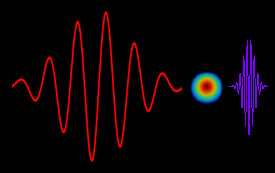Two spectroscopic approaches developed in the ATTOphysics group provide access to attosecond dynamics.
These are photoemission spectroscopy and harmonic spectroscopy.


Photoemission spectroscopy
Photoemission spectroscopy enables the study of a wide variety of electronic and nuclear dynamics in excited/ionized species in valence or inner layers.
A key application is the real-time study of the quantum process of photoemission, whether in the gas, liquid or solid phase. This spectroscopy makes it possible to measure the minute delays between the emission of electrons from different valence and core layers, and to quantify electron trapping times on intermediate resonances.
Combined with electron-momentum imaging, the 3D film of the wave packet ejection can be reconstructed, providing access to electronic correlations and rearrangements in the ion.
Harmonic spectroscopy
Harmonic spectroscopy, based on the process of generating high-order harmonics, is a highly efficient probe of the structure and dynamics of the target gas, combining attosecond temporal resolution with sub-Angstrom spatial resolution.
It thus enables the imaging of molecular orbitals by quantum tomography, and the study of attosecond electronic dynamics initiated by tunnel ionization, such as charge migration.
Accessible dynamics are those initiated in the valence/inner valence layer, and the range of timescales probed extends to the fundamental laser period.



